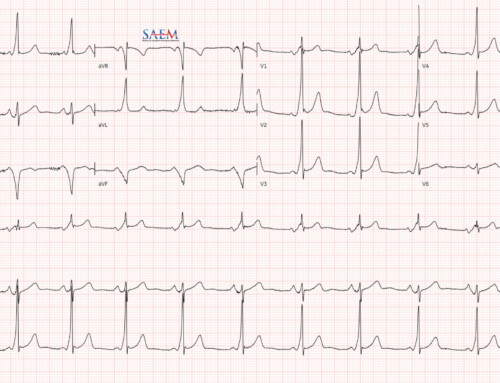
There is an abundance of sympathetic stimulation in patients who present in ventricular fibrillation (VF) or pulseless ventricular tachycardia (VT) whether endogenously released as a stress response or exogenously administered in a resuscitation attempt.1 The hope is that sympathetic stimulation will increase the coronary and cerebral perfusion pressure of the patient and aid in resuscitation. However, there are numerous detrimental effects associated with epinephrine such as an increase in myocardial oxygen demand leading to increased ischemia.2
Contrary to traditional teaching, interesting evidence exists in both animal models as well as in limited reports in human subjects that show a potential benefit with beta blockade in cardiac arrest.
ANIMAL STUDIES
In a porcine VF model, this unopposed alpha-stimulation resulted in higher systolic and diastolic aortic pressure and coronary perfusion pressure before defibrillation when treated with atenolol and epinephrine versus epinephrine and placebo. Nine of the 10 pigs in the intervention group achieved return of spontaneous circulation (ROSC) while only 4 of 10 pigs in the epinephrine/placebo group achieved the same end point. The atenolol group also required fewer defibrillation attempts to achieve ROSC.3 This is just one of the many examples of animal trials available in the literature to date.
Animal trials leave much to be desired when evaluating this intervention for human use. For starters, animal trials incorporate beta blockade at the beginning of resuscitation. It is unclear whether incorporating beta blockade later in the resuscitation attempt will produce the same outcomes. Secondly, animal trials are unable to evaluate the neurologic outcomes of their subjects. Finally, the animals tested lack the underlying disease that we will see in the patients presenting to our emergency departments. Fortunately, we have compelling pieces of evidence that beta blockade may be beneficial for some human cardiac arrest patients. For example, this benefit has been shown in hospitalized patients with known electrical storm treated with sympathetic blockade when compared to advanced cardiac life support (ACLS) therapy.4
HUMAN STUDIES
Recently, a retrospective review by Driver and colleagues compared the outcomes of patients treated with esmolol versus those who received care without a beta blocking intervention.5 Esmolol was selected due to its rapid onset and short duration of action. This review examined patients who had VF refractory to standard therapy (at least 3 defibrillation attempts, at least 3 doses of epinephrine, and a minimum of 300 mg amiodarone). Patients meeting these inclusion criteria treated with and without esmolol were compared. Remarkably, of the 6 patients treated with esmolol, 4 achieved ROSC and 3 (50%) survived to discharge with good neurologic function despite prolonged CPR times of approximately one hour. Of the 19 patients in the comparator group, 6 achieved ROSC, 3 survived to discharge (16%) and 2 had good neurologic outcomes (11%; no differences statistically significant). While many factors may have contributed to these outcomes (chance, mechanical CPR, impedance threshold device, careful selection of patients, etc), it is reasonable for EM providers to consider beta blocking therapy in select patients due to the universally poor outcomes associated with prolonged cardiac arrest.
INHALATIONAL ABUSE
Another patient population in which beta blockade may theoretically be beneficial includes patients with suspected inhalation abuse. It is theorized that inhalation abuse results in sensitization of the myocardium, making the patient susceptible to cardiac events.6 “Sudden sniffing death” most commonly presents in patients who were abusing inhalants and had sudden sympathetic stimulation such as fear (being caught) or exercise.7 While there are not documented case reports of beta blocker therapy for this highly specific indication, it stands to logic that beta blockade may be able to overcome the sympathetic stimulation on the heart and possibly produce a benefit in this subset of cardiac arrest patients.
CONCLUSION
While I do not advocate the use of beta blockade in all cardiac arrest patients, esmolol may be considered in selected patient populations. Beta blockade should be considered in patients who are non-responsive to traditional ACLS therapies and continue to have shockable rhythms. Esmolol would be my agent of choice due to its extremely quick onset and duration of action. Like all medications however, esmolol is not without risk. Careful attention and clinical judgment must be applied to all patients with specific attention to hemodynamic status looking for evidence of cardiogenic shock.
TAKE HOME POINTS
- Detrimental effects of adrenergic stimulation may hinder the ability to achieve ROSC in some cardiac arrest patients.
- Use judgment: In patients who do not respond to conventional care via the ACLS algorithm AND continue to have shockable rhythms, beta blockade may be considered.
- Beta blockade may also benefit patients who are suspected to have abused inhalants prior to arrest, especially if found in situation of physical or emotional stress.
- Esmolol is the ideal beta blocker currently available due to its pharmacokinetic and pharmacodynamic profile.
- Monitor patients for efficacy and adverse effects of beta blockade and adjust therapy accordingly




